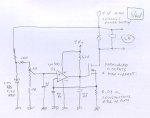Hi
I need to build a constant current laser diode driver.
I have all the logic circuit designed to monitor temperature, TEC cooling control and turn off/on the laser diode power input but I am still lacking a high power constant current driver.
In another post (http://laserpointerforums.com/f39/wtb-laser-power-supply-46196.html), I mentioned I will be using a TI PTH08T250W unit.
I will feed it 12 V from a PC power supply.
It will regulate the output to about 2.2V; which is the estmated lasing voltage for the laser diode.
However, I need to regulate the current as well to about 40-49 amps.
Does anyone has a circuit (MOSFET, etc.) to do that at about 1.5V to 2.5V?
Thanks!
I need to build a constant current laser diode driver.
I have all the logic circuit designed to monitor temperature, TEC cooling control and turn off/on the laser diode power input but I am still lacking a high power constant current driver.
In another post (http://laserpointerforums.com/f39/wtb-laser-power-supply-46196.html), I mentioned I will be using a TI PTH08T250W unit.
I will feed it 12 V from a PC power supply.
It will regulate the output to about 2.2V; which is the estmated lasing voltage for the laser diode.
However, I need to regulate the current as well to about 40-49 amps.
Does anyone has a circuit (MOSFET, etc.) to do that at about 1.5V to 2.5V?
Thanks!






